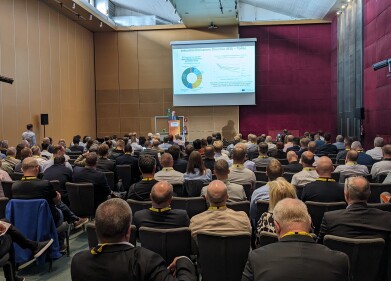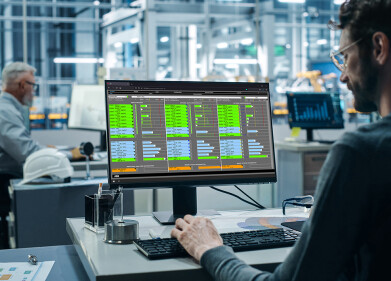Air monitoring
Simulating the Effect of Climate Change on Agriculture
Dec 07 2017
Increased atmospheric CO2 levels and climate change are believed to contribute to extreme weather conditions, which is a major concern for many. And beyond extreme events, global warming is also predicted to affect agriculture.
While climate change is expected to affect agriculture and reduce crop yields, the complete effects of climate change on agriculture and the resultant human food supplies are yet to be fully understood.2,3,4
Simulating a Changing Climate
In order to understand how changes in CO2, temperature and water availability caused by climate change have an impact on crop growth and food availability, Researchers often use controlled growth chambers to grow plants in conditions that mimic the predicted atmospheric conditions at the end of the century. These controlled growth chambers enable precise control of temperature, CO2 levels, humidity, water availability, light quality and soil quality, allowing Scientists to study how plant growth changes in response to elevated temperatures, elevated CO2 levels and altered water availability.
However, plant growth / behaviour in the field considerably varies from in growth chambers. Owing to differences in light intensity, light quality, evaporative demand, temperature fluctuations and other abiotic and biotic stress factors, the growth of plants in tiny, controlled growth chambers does not always sufficiently reflect plant growth in the field. Moreover, the less realistic the experimental conditions used during simulation experiments of climate change, the less likely the resultant predictions will reflect reality.4
Several attempts have been made over the past 30 years to more closely stimulate climate change growing scenarios including free air CO2 enrichment, open top chambers, free air temperature increases and temperature gradient tunnels, although all these methods are known to have major disadvantages. For instance, chamber-less CO2 exposure systems do not enable stringent control of gas concentrations, while other systems suffer from “chamber effects” such as changes in humidity, wind velocity, temperature, soil quality and light quality.4,5
Spanish Researchers have recently reported temperature gradient greenhouses and growth chamber greenhouses, which are specifically designed to remove some of the disadvantages of simulating the effects of climate change on crop growth in growth chambers. An article reporting their methodology was featured in Plant Science in 2014, describing how the Researchers used temperature gradient greenhouses and growth chamber greenhouses to simulate climate change conditions and study plant responses.4
Choosing the Right Growth Chamber
Compared to traditional growth chambers, temperature gradient greenhouses and controlled growth chambers offer increased working area, allowing them to work as greenhouses without the necessity for isolation panels while still allowing precise control of various environmental factors such as temperature, CO2 concentration and water availability.
Researchers have used these greenhouses to investigate the potential effects of climate change on the growth of grapevine, alfalfa and lettuce.
CO2 Sensors for Climate Change Research
Researchers investigating the effects of climate change on plant growth using greenhouses or growth chambers will require highly accurate CO2 measurements.
The Spanish Researchers used Edinburgh Sensors Guardian sensor in their greenhouses to provide accurate and reliable CO2 measurements. As a customer-focused provider of high-quality gas sensing solutions, Edinburgh Sensors has been delivering gas sensors to the research community since the 1980s.4,6
The Guardian NG from Edinburgh Sensors
The Edinburgh Sensors Guardian NG provides precise CO2 measurements in research greenhouses simulating climate change scenarios. The sensor provides near-analyser quality continuous measurement of CO2 concentrations, operates in temperatures of 0-45 °C and relative humidity of 0-95%, and has a CO2 detection range of 0 to 3000 ppm. These features make Guardian NG suitable for use in greenhouses with conditions meant to simulate climate change scenarios.
In addition, the Guardian NG can be easily installed as a stand-alone product in greenhouses to measure CO2, or in tandem with CO2 controllers as done by the Spanish Researchers in their temperature gradient and growth control greenhouses.4,6
Conclusions
In order to understand the potential effects of climate change on plant growth and crop yields, it is important to simulate climate change scenarios in elevated CO2 concentrations. For such studies, accurate CO2 concentration measurements are very important.
The Guardian NG from Edinburgh Sensors is the ideal option for Researchers constructing research greenhouses for climate change simulation
For further information please click here.
Digital Edition
AET 28.4 Oct/Nov 2024
November 2024
Gas Detection - Go from lagging to leading: why investment in gas detection makes sense Air Monitoring - Swirl and vortex meters will aid green hydrogen production - Beyond the Stack: Emi...
View all digital editions
Events
Jan 12 2025 Abu Dhabi, UAE
Jan 14 2025 Abu Dhabi, UAE
Jan 20 2025 San Diego, CA, USA
Carrefour des Gestions Locales de L'eau
Jan 22 2025 Rennes, France
Safety, Health & Wellbeing LIVE
Jan 22 2025 Manchester, UK



















